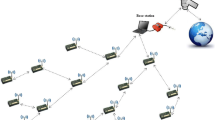Abstract
Wireless Sensor Networks have turned into a principal determination of various critical applications, like, target following, modern robotization, and message transformation etc. Commonly, a WSN comprises of an extensive number of small, low-cost sensor hubs that are conveyed in the target range for gathering information of intrigue. But, secure data packets transmission is the main critical issue –− + in this network because WSNs vulnerable to malicious attacks such as black hole and warm hole. In this paper, Hybrid Anomaly Detection Systems (HADS) called as Artificial Immune System is proposed in the WSNs. In this framework, developinga novel intrusion detection algorithm using Hybrid Tissue Growing Algorithm (HTGA) for identifying theanomalies presence cell and efficiently the communication tissue structure for transmitting the data packets is done. This algorithm is applied into two different developments such as Networked Tissue Growing (NTG) model and the Swarm Tissue growing (STG) algorithm. Both are autonomous in the capacity to create cautions in term of recognizing abnormalities in the route sections. The complexity calculation is primary nature depends onthe number of entry in the neighbor table and route discovery. If the tissue, predicts a week cell and then automatically rejects that cell for preventing from an intruder. The network based calculation expressly keeps up the cell in a dynamic clustering nature. This paper intends to make a relevantly mindful IDS by joining the idea of tissues, which will gives a more vigorous, versatile and precise security against assaults in interloper assaults in the sensor network. The simulation results of the proposed HADS technique is compared with the existing techniques such as LDTS, EED-M, and the NTMS-DS. Hence, the proposed HADS framework achieves greater performance than the existing methods.







Similar content being viewed by others
References
Abduvaliyev A, Pathan A-SK, Zhou J, Roman R, Wong W-C (2013) On the vital areas of intrusion detection systems in wireless sensor networks. IEEE Communications Surveys & Tutorials 15:1223–1237
Dhangar K, Kulhare D, Khan A (2013) Analysis of proposed intrusion detection system. Int J Comput Appl 65
Soliman OS, Rassem A (2014) A network intrusions detection system based on a quantum bio inspired algorithm. arXiv preprint arXiv:1405.1404
Assad N, Elbhiri B, Faqihi MA, Ouadou M, Aboutajdine D (2016) Efficient deployment quality analysis for intrusion detection in wireless sensor networks. Wirel Netw 22:991–1006
Rajeshkumar G, Valluvan K (2017) An energy aware trust based intrusion detection system with adaptive acknowledgement for wireless sensor network. Wirel Pers Commun: 94: 1993–2007
Puri A, Sharma N (2017) A survey on intrusion detection system,System," International Journal of Engineering Development and Research (IJEDR), 5:123–126, 2017.
Alrajeh NA, Khan S, Shams B (2013) Intrusion detection systems in wireless sensor networks: a review. International Journal of Distributed Sensor Networks 9:167575
Eswari T, Vanitha V (2013) A novel rule based intrusion detection framework for wireless sensor networks. In: 2013 international conference on information communication and embedded systems (ICICES), 2013, pp 1019–1022
Pantazis NA, Nikolidakis SA, Vergados DD (2012) Energy-efficient routing protocols in wireless sensor networks: a survey. IEEE Communications surveys & tutorials 15:551–591
Butun I, Morgera SD, Sankar R (2014) A survey of intrusion detection systems in wireless sensor networks. IEEE communications surveys & tutorials 16:266–282
Han G, Li X, Jiang J, Shu L, Lloret J (2014) Intrusion detection algorithm based on neighbor information against sinkhole attack in wireless sensor networks. Comput J 58:1280–1292
Khan F (2014) Secure communication and routing architecture in wireless sensor networks. In: Consumer electronics (GCCE), 2014 IEEE 3rd global conference on, pp 647–650
Kumar ES, Kusuma S, Kumar BV (2014) A random key distribution based artificial immune system for security in clustered wireless sensor networks. In: 2014 IEEE students’ conference on electrical, electronics and computer science (SCEECS), pp 1–7
Bartariya S, Rastogi A (2016) Security in wireless sensor networks: attacks and solutions. International Journal of Advanced Research in Computer and Communication Engineering (IJARCCE), vol 5
Xiao X, Zhang R (2017) Study of immune-based intrusion detection technology in wireless sensor networks. Arab J Sci Eng:1–16
Hamad IEH, Abid M (2017) BTRMC, a bio-inspired trust and reputation model using clustering in WSNs. In: 2017 international conference on smart, monitored and controlled cities (SM2C), pp 5–11
Zhang W, Zhu S, Tang J, Xiong N (2017) A novel trust management scheme based on Dempster–Shafer evidence theory for malicious nodes detection in wireless sensor networks. J Supercomput:1–23
Author information
Authors and Affiliations
Corresponding author
Additional information
Publisher’s note
Springer Nature remains neutral with regard to jurisdictional claims in published maps and institutional affiliations.
Rights and permissions
About this article
Cite this article
Umarani, C., Kannan, S. Intrusion detection system using hybrid tissue growing algorithm for wireless sensor network. Peer-to-Peer Netw. Appl. 13, 752–761 (2020). https://doi.org/10.1007/s12083-019-00781-9
Received:
Accepted:
Published:
Issue Date:
DOI: https://doi.org/10.1007/s12083-019-00781-9




